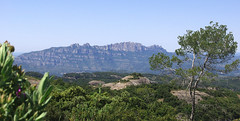The British Overseas Territory of Montserrat is part of the Lesser Antilles island chain found in the Leeward Islands. The tiny island is sometimes called The Emerald Isle of the Caribbean because of its keen resemblance to the coasts of Ireland. It’s not surprising, perhaps, that the island boasts a significant population with Irish roots.

The island was discovered by Christopher Columbus in 1493, as he was making his second voyage to the New World. He claimed the island and named it Santa Maria de Montserrat, in honor of the Montserrat Monastery in Catalonia, Spain.
Apparently, little was done to develop the island until it fell under British control in 1632. Settlement began when fierce anti-Catholic sentiments arose on the nearby island of Nevis, and a large group of Irish Catholic slaves were forcibly transplanted to Montserrat.
A sort of neo-feudal colony was built up, largely on the backs of slaves. First Irish slaves arrived, followed by many African slaves, brought in to work on the local plantations. As was the case on many Caribbean islands, the economy of Montserrat was largely based on rum, sugar, cotton, and arrowroot. By the late 18th century, plantations covered much of the island, manned by hundreds of slaves.
At the same time, Oliver Cromwell was sending shiploads of exiled Irish people to the island, along with many political prisoners, orphans, and unemployed poor. Many who were a financial burden to the public purse at home were shipped off to work on the plantations of Montserrat.
While Britain was distracted by the American Revolutionary War in 1782, the French swooped in and briefly captured the island. French rule was fairly short-lived however, and rule of Montserrat was returned to Great Britain under the Treaty of Paris.
In 1834, slavery was abolished in Montserrat, and that factor – combined with falling sugar prices – led to a dramatic downturn in the island’s economy. Plantation owners were at a loss until 1857 when British philanthropist Joseph Sturge bought up a sugar estate and proved that plantations could be commercially viable even without depending on slave labour.

Many members of the Sturge family followed, buying up plots of land all over the island and planting vast groves of lime trees. The Sturges established the Montserrat Company Ltd. and set up a plant for processing lime juice on a commercial level. Eventually, the company sold off small parcels of land to various islanders who in turn began to develop the land further.
Throughout the late 19th and early 20th centuries, Montserrat was included as part of the British Leeward Islands colony. For a brief stint, it was made a province of the West Indies Federation; however, this was dissolved in 1962.
In recent years, Montserrat has been the victim of serious natural disasters, including Hurricane Hugo in 1989, and the eruption of Montserrat’s Soufriere Hills volcano in 1995. Many portions of the island are now uninhabitable. An estimated 8000 refugees fled the island following these events.
Today’s population of around 5800 is made up of a mix of British, Irish and African descendants. English is widely spoken, along with a creole dialect.





One Reply to “Relics of Empire: Montserrat”